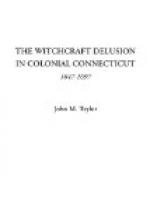Mr. Phelps John White John More Mr. Tailecoat Will Leawis Edw. Griswold Mr. Hollister Sam. Smith Steph. Harte Daniel Milton John Pratt Theo. Judd
Before this tribunal—representative of the others doing like service later—made up of the foremost citizens, and of men in the ordinary walks of life, endowed with hard common sense and presumably inspired with a spirit of justice and fair play, came John Carrington and his wife Joan of Wethersfield, against whom the jury brought in a verdict of guilty.
It must be clearly borne in mind that all these men, in this as in all the other witchcraft trials in Connecticut, illustrious or commonplace—as are many of their descendants whose names are written on the rolls of the patriotic societies in these days of ancestral discovery and exploitation—were absolute believers in the powers of Satan and his machinations through witchcraft and the evidence then adduced to prove them, and trained to such credulity by their education and experience, by their theological doctrines, and by the law of the land in Old England, but still clothed upon with that righteousness which as it proved in the end made them skeptical as to certain alleged evidences of guilt, and swift to respond to the calls of reason and of mercy when the appeals were made to their calm judgment and second thought as to the sins of their fellowmen.
In no way can the truth be so clearly set forth, the real character of the evidence be so justly appreciated upon which the convictions were had, as from the depositions and the oral testimony of the witnesses themselves. They are lasting memorials to the credulity and superstition, and the religious insanity which clouded the senses of the wisest men for a time, and to the malevolence and satanic ingenuity of the people who, possessed of the devil accused their friends and neighbors of a crime punishable by death.
Nor is this dark chapter in colonial history without its flashes of humor and ridiculousness, as one follows the absurd and unbridled testimonies which have been chosen as completely illustrative of the whole series in the years of the witchcraft nightmare. They are in part cited here, for the sake of authenticity and exactness, as written out in the various court records and depositions, published and unpublished, in the ancient style of spelling, and are worthy the closest study for many reasons.
It will, however, clear the way to a better understanding of the unique testimonies of the witch witnesses, if there be first presented the authoritative reasons for the examination of a witch, coupled with a summary of the lawful tests of innocence or guilt. They are in the handwriting of William Jones, a Deputy Governor of Connecticut and a member of the court at some of the trials.




